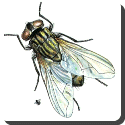 Housefly — The housefly (also house fly or house-fly), Musca domestica, is the most common fly occurring in homes, the most familiar of all flies and indeed one of the most widely distributed animals; it is a pest that can carry and transmit serious diseases.
Housefly — The housefly (also house fly or house-fly), Musca domestica, is the most common fly occurring in homes, the most familiar of all flies and indeed one of the most widely distributed animals; it is a pest that can carry and transmit serious diseases.
The adults are 5-8 mm long. Their thorax is gray, with four dark longitudinal lines on the back, the underside of their abdomen is yellow, and their whole body is covered with hair. The females are slightly larger than the males and have a much larger space between their red compound eyes.
Like most Diptera (meaning “two-winged”), houseflies have only one pair of wings; the hind pair is reduced to small halteres that aid in flight stability. Characteristically, the media vein (M1+2 or fourth long vein of the wing) shows a sharp upward bend.
Species that appear similar to the housefly include:
- The lesser house fly, Fannia canicularis, is somewhat smaller, more slender, and the media vein is straight.
- The stable fly, Stomoxys calcitrans, has piercing mouthparts and the media vein is only slightly curved.
These houseflies are subjects of study by scientists all over the world.
Each female fly can lay over 9,000 eggs. The eggs are white and are about 1.2 mm in length. Within a day, the larvae (maggots) hatch from the eggs; they live and feed in (usually dead and decaying) organic material, such as garbage or faeces. They are pale whitish, 3-9 mm long, thinner at the mouth end, and have no legs. At the end of their third instar, the maggots crawl to a dry cool place and transform into pupae, colored reddish or brown and about 8 mm long. The adult flies then emerge from the pupae. (This whole cycle is known as complete metamorphosis.) The adults live from half a month to a month in the wild, or longer in benign laboratory conditions. After having emerged from the pupae, the flies cease to grow; small flies are not young flies but the result of insufficient food during the larval stage.
In colder climates, houseflies occur only with humans. They have a tendency to aggregate and are difficult to dispel. They are capable of carrying over 100 pathogens, such as typhoid, cholera, Salmonella, bacillary dysentery, tuberculosis, anthrax, ophthalmia, and parasitic worms. The flies in poorer and lower-hygiene areas usually carry more pathogens. Some strains have become immune to most common insecticides.
 Kids Portal For Parents India Kids Network
Kids Portal For Parents India Kids Network
